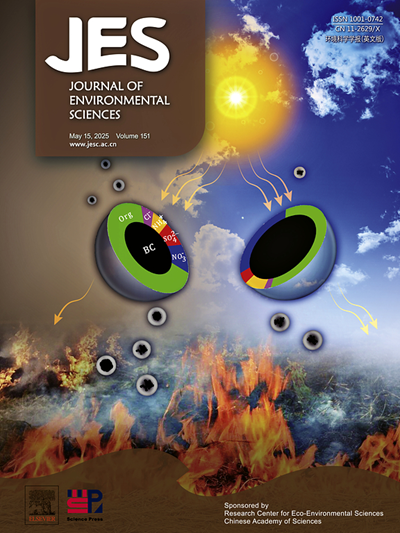Fractionation of water-soluble organic matter (WSOM) with polyvinylpyrrolidone: A study on antimony associated with WSOM in contaminated soils
IF 6.3
2区 环境科学与生态学
Q1 ENVIRONMENTAL SCIENCES
引用次数: 0
Abstract
Water-soluble organic matter (WSOM) significantly influences the transport of metals and organic contaminants in soils, yet the interaction specifics with antimony (Sb) remain largely unexplored. Antimony is of particular environmental concern due to its toxic properties and harmful effects on ecosystems and human health. Employing a three-step fractionation method with polyvinylpyrrolidone (PVP), this study aimed to isolate and analyze humic acids (HA), PVP-non adsorbed fulvic acids (FAA), and PVP-adsorbed fulvic acids (FAB) from WSOM in soil spiked with Sb and incubated for 18 months. These fractions underwent chemical analysis for carbon (C), nitrogen (N), total organic carbon (TOC), and Sb, complemented by FTIR and 1H NMR spectroscopic characterization. The study revealed that HA was more aliphatic, with Sb predominantly associating with the fulvic acid (FA) fraction, accounting for 97 % of Sb in extracts. Specifically, the FAA subfraction held substantial portions of total carbon (TC), total nitrogen (TN), total organic carbon (TOC), and Sb. Correlations between Sb concentrations and TN, TC, and TOC were significant. Extraction methods showed NaOH and Na4P2O7 outperformed HCl and deionised water in extracting TC, TN, and TOC, with higher Sb concentrations found in Na4P2O7 and NaOH extracts. This underscores the role of Fe/Al-SOM complexes in Sb soil availability. The results revealed that FAA subfraction accounted for 76 %, 64 % and 94 % of TN, TOC and Sb, respectively. Therefore, this research highlights the FAA fraction's central role, predominantly comprising non-humic substances like amines, in the availability of C, N, and Sb in Sb-impacted soils. The findings offer insights for environmental management and remediation strategies.

水溶性有机物(WSOM)与聚乙烯吡咯烷酮的分选:污染土壤中与WSOM相关的锑的研究
水溶性有机物质(WSOM)显著影响土壤中金属和有机污染物的迁移,但与锑(Sb)的相互作用细节仍未得到充分研究。锑因其有毒特性和对生态系统和人类健康的有害影响而引起特别的环境关注。采用聚乙烯吡罗烷酮(PVP)三步分离法,在添加Sb的土壤中分离腐殖酸(HA)、PVP-非吸附黄腐酸(FAA)和PVP-吸附黄腐酸(FAB),并对其进行分析。对这些馏分进行了碳(C)、氮(N)、总有机碳(TOC)和Sb的化学分析,并进行了FTIR和1H NMR表征。研究表明,透明质酸主要是脂肪族的,Sb主要与黄腐酸(FA)部分结合,占提取物中Sb的97%。具体来说,FAA亚组分含有大量的总碳(TC)、总氮(TN)、总有机碳(TOC)和锑。锑浓度与TN、TC和TOC之间存在显著的相关性。提取方法表明,NaOH和Na4P2O7对TC、TN和TOC的提取效果优于HCl和去离子水,且Na4P2O7和NaOH提取物中Sb的浓度更高。这强调了Fe/Al-SOM配合物在Sb土壤有效性中的作用。结果表明,FAA亚组分分别占TN、TOC和Sb的76%、64%和94%。因此,本研究强调了FAA组分的核心作用,主要包括非腐殖质物质,如胺,在受Sb影响的土壤中,C、N和Sb的有效性。这些发现为环境管理和补救策略提供了见解。
本文章由计算机程序翻译,如有差异,请以英文原文为准。
求助全文
约1分钟内获得全文
求助全文
来源期刊

Journal of Environmental Sciences-china
环境科学-环境科学
CiteScore
13.70
自引率
0.00%
发文量
6354
审稿时长
2.6 months
期刊介绍:
The Journal of Environmental Sciences is an international journal started in 1989. The journal is devoted to publish original, peer-reviewed research papers on main aspects of environmental sciences, such as environmental chemistry, environmental biology, ecology, geosciences and environmental physics. Appropriate subjects include basic and applied research on atmospheric, terrestrial and aquatic environments, pollution control and abatement technology, conservation of natural resources, environmental health and toxicology. Announcements of international environmental science meetings and other recent information are also included.
 求助内容:
求助内容: 应助结果提醒方式:
应助结果提醒方式:


